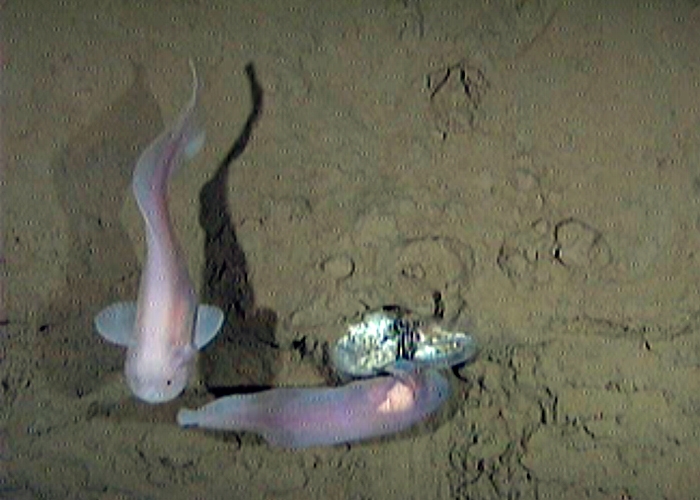“Pseudoliparis amblystomopsis”
Scientists have discovered the world’s deepest-dwelling fish during research in the Mariana Trench of the Pacific Ocean. They captured video footage of Snailfish at depths of 8,145 meters (26,700 feet). Slithering fish on the ocean floor are more numerous than experts realized. Snailfish are small, growing to a maximum length of about 30 centimeters (12 inches). They are elongated, soft, tadpole-shaped fish with loose and scaleless, though sometimes prickly skins. There is a long dorsal fin on the back and usually a sucking disk below the head. The disk is formed from the pelvic fins and is used for attachment to the bottom. Scientists studying the ocean’s deepest reaches more than 3.7 miles (6 kilometers) deep in what’s called the Hadal zone discovered that some species of fish are more abundant than previously thought. Marine biologists found between 10 to 20 Snailfish writhing at 4.8 miles (7.7 kilometers) below the ocean surface around a baited video lander in the Japan Trench, a 5.7 mile (9-kilometers) deep gorge in the famous seismically & volcanically active Ring of Fire region in the Pacific Ocean. The number of fish may not seem like much, but because the research team could only film for 5 hours, they were surprised to find so many Snailfish. Their diet consists primarily of small crustaceans, mollusks, polychaete worms and other small invertebrates.
Scientists distinguished at least 10 individual fish and recorded their behavior, which was similar to the behavior of fish observed in 1965 from a bathyscaphe (submersible) at a depth of 4.5 miles (7.3 kilometers) in the western Atlantic Ocean. Today, the deep sea is still mysterious because observations at such extreme depths 5 times farther down than the oil leak in the Gulf of Mexico, are technically demanding & consequently rare. Because of the lack of observations, marine biologists do not know much about Snailfish, including how long they live and how they mingle with shallow-water fish. The Snailfish is poorly studied and few specifics are known. Their elongated, tadpole-like bodies are similar in profile to the Rattail fish. Their heads are large with small eyes; their bodies are slender to deep, tapering to very small tails. The extensive dorsal & anal fins may merge or nearly merge with the tail fin. Snailfish are scaleless with a thin, loose gelatinous skin and have prickly spines as well. Their teeth are small and simple with blunt cusps. The Snailfish have prominent, well-developed sensory pores on the head, part of the animals’ lateral line-system. Previous records of Snailfish supposedly captured at great depth are rare and mostly based on trawls, a technique that is subject to uncertainty about exactly when a fish entered the trawl net. The researchers for the new study recorded an illuminated patch of the seafloor for 1 minute every 5 minutes. The Snailfish fed on crustaceans that were attracted to the mackerel bait on the camera. Snailfish only lay a few hundred eggs, compared to the “as many as theoretically possible” approach of most fish. Some Snailfish have even been seen mouth brooding, where a parent carries the eggs around in their mouth. Snailfish reside exclusively in deep trenches in the Pacific Ocean, at depths below 4 miles (nearly 7 kilometers). They contend with total darkness, near freezing temperatures & water pressures equivalent to 1,600 African Elephants standing on the roof of a small car. All species are known to lay a small number (about 300) of relatively large eggs (4.5–8 millimeters in diameter). The deep-sea equipment needed to survive the extreme pressure at these depths, takes 5 hours to reach the depths of the trenches and allowed to remain on the seafloor for 2 days before the signal is given to surface.


















































